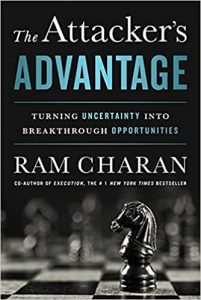
The aim of this book is to help understand and respond with appropriate action in today’s fluid and uncertain business environment. Author Ram Charan elucidates from several interviews of effective individuals who are champions of recognizing uncertainty and making a profit out of it. Charan offers practical advice instead of just dull abstract theories.
Dealing with uncertainty lies in leadership:
- As we continue to progress in time, the world continues to get more uncertain and is hurdles with various threats. The global financial system requires reform.
- The rise of new competitors from unexpected places is reshaping and changing the landscape of how business works today.
- Radical change today is qualitatively different from before. Structural uncertainty has the capacity to change the market completely in the blink of an eye.
- Today leaders struggle with developing specific situational guidelines for dealing with uncertainty.
Foreseeing Uncertainty:
One must anticipate change and see uncertainty becoming. This mindset has five key components:
- Perceptual acuity: Embrace change. Strive to grow mentally and psychologically ready. Learn to look ahead, pay close attention and understand the activities you observe. Be on the lookout for symptoms of threats and disturbance. Some individuals have innate perceptual acuity, but one can always develop and improve it.
- Seeing the opportunity in uncertainty: Powerful modern leaders recognise the opportunity in these uncertainties. When you notice an opportunity, lead your organization through it.
- Seeing a path and committing to it: Once you identify the opportunities, distinguish a path that points to them. Doing this demands hard choices to be made, like withdrawing from core business activities because you observe the shift in the market.
- Managing changes properly: Exploring a new path requires significant personal and organizational reforms. Leadership needs to acquire skills to handle these shifts and allow for a smooth change for the organization and its stakeholders.
- Make your organization agile: For an organization to move, and move fast, it must be agile. Join staff responsibilities to the outside world and form metrics that lead employees in the actions you need them to take.
# Key Takeaways:
– The Attackers Advantage emphasizes the importance of being proactive and constantly seeking new opportunities in order to stay ahead in a competitive market.
– The book argues that traditional business strategies, such as cost-cutting and efficiency, are no longer enough to sustain success. Instead, companies must focus on innovation and disruption to gain a competitive advantage.
– The author, Ram Charan, provides a framework for identifying and capitalizing on opportunities, which includes understanding customer needs, leveraging technology, and building a strong team.
# Practical Application:
– The concepts and strategies outlined in The Attackers Advantage can be applied in real-world scenarios by encouraging a culture of innovation within an organization. This can involve setting up cross-functional teams, investing in research and development, and constantly seeking feedback from customers.
– The book also emphasizes the importance of being open to change and adapting quickly to new market trends. This can involve regularly reviewing and updating business strategies, as well as being willing to take risks and try new approaches.
# Valuable Insights for Leaders and Managers:
– Chapter 3, “The Attackers Mindset,” offers valuable insights for individuals in leadership or management roles. It discusses the importance of having a growth mindset and constantly seeking new opportunities, as well as the need for leaders to be adaptable and open to change.
– Chapter 5, “The Attackers Framework,” provides a practical framework for identifying and capitalizing on opportunities. This can be particularly useful for leaders and managers who are looking to drive innovation and disruption within their organization.
# Case Studies and Examples:
– The book includes several case studies and examples that effectively illustrate its principles. One example is the story of Netflix and how it disrupted the traditional video rental market by leveraging technology and understanding customer needs.
– Another case study is the story of Amazon and how it continuously innovates and disrupts various industries, such as retail and cloud computing. These examples demonstrate the importance of being proactive and constantly seeking new opportunities in order to stay ahead in a competitive market.
Leave a Reply